


Meeting report
European Crystallography Meeting
Sweden August 6-11 1995
Opening Session
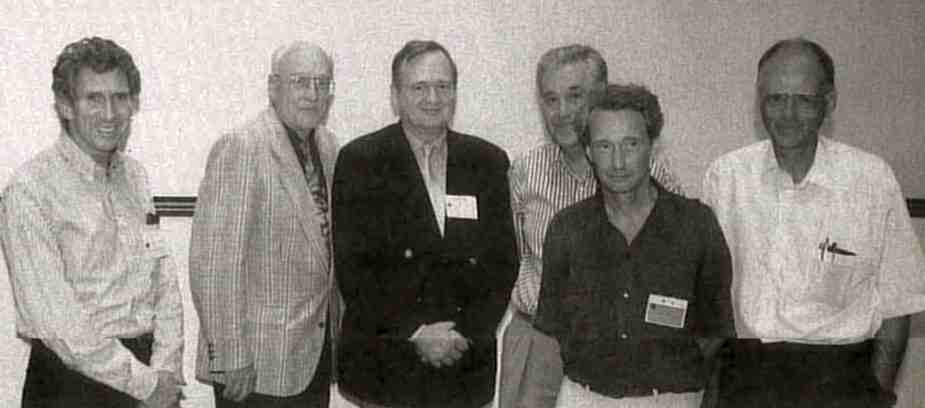 At the opening ceremony (from left), keynote lecturers, Ken Holmes (Heidelberg) and Levi Tansjo (Lund), newly elected president of the European Crystallographic Society. Hartmut Fuess, program chair Jorgen Abertsson, local chair, Ake Oskarsson and Bengt E. L. vensson, Prorektor of Lund University. Photo W.L.D.
At the opening ceremony (from left), keynote lecturers, Ken Holmes (Heidelberg) and Levi Tansjo (Lund), newly elected president of the European Crystallographic Society. Hartmut Fuess, program chair Jorgen Abertsson, local chair, Ake Oskarsson and Bengt E. L. vensson, Prorektor of Lund University. Photo W.L.D.
At the Opening Session of ECM 16 more than 500 participants were welcomed by the Vice President of Lund U., B. Svensson and ECC chairman, H. Fuess. Opening addresses were delivered by K. Holmes, MPI for Medical Research, Heidelberg and L. Tansjo (Lund). In a tour de force lecture Holmes surveyed the strengths of current techniques in structural biology and their potential for curing disease and improving health. He made a remarkably convincing case to support his call for 50,000 academic chairs in structural biology. He predicted that the pace of discoveries based upon the twin pillars of synchrotron radiation and gene sequencing will continue to accelerate until the end of time. He used recent studies of the structure and function of muscle as an example of how data from a variety of powerful sources including X-ray crystallography, NMR, cryo electron microscopy and fiber diffraction can be combined to study highly complex multicomponent systems. In his lecture entitled "X-rays and the Emergence of Modern Chemistry" Dr Tansjo gave a witty description of the discovery of X-rays, its immediate consequences and Roentgen's inaccessible personality. By connecting the discovery of X-rays with Thomson's electron, Rydberg's constant, Moseley's spectroscopic investigations and the von Laue, Friedrich & Knipping experiment, Tansjo argued that "Modern Chemistry" began with the discoveries of Roentgen and Thomson not, as is usually suggested, with the work by Lavoisier in the 1780's. He noted thar Rydberg did his work in Lund. (J. Albertsson.)
Macromolecular crystallography
Enzymes: The raison d'être of macromolecular crystallography is to relate structure to function, and it is becoming increasingly clear that, particularly in the case of enzymes, one cannot expect to answer all questions from a single crystallographic structure no matter how high the quality of the structure. The availability of numerous lipase structures discussed by C. Cambilleau has suggested a correlation between the size of the active site "lid" and the length of the substrate, but the structural features which distinguish an esterase from a lipase or which allow some enzymes to perform both roles remain unclear. The very high resolution structure of cutinase (as found in many washing powders) in combination with extensive mutagenesis and analysis of complexes with inhibitors has provided a picture of how these conformationally flexible molecules might bind at the active site, but even with the backing of the detergent manufacturers questions still remain.
Nature has provided several answers to the problem of obtaining efficient redox reactions within the limitation of the 20 available amino-acids, and S. Phillips described the example of amine oxidase where a combination of a modified tyrosine (TPQ) and a metal ion provide a 2e-reaction. In this case the first crystals (grown from ammonium sulphate) proved to be inactive, casting doubt on some previous spectroscopic results. A new crystal form grown from citrate revealed a dramatically different orientation of the TPQ group. However, apparent stereochemical conflicts are observed which remain to be resolved, either with higher resolution data or yet another set of crystallization conditions.
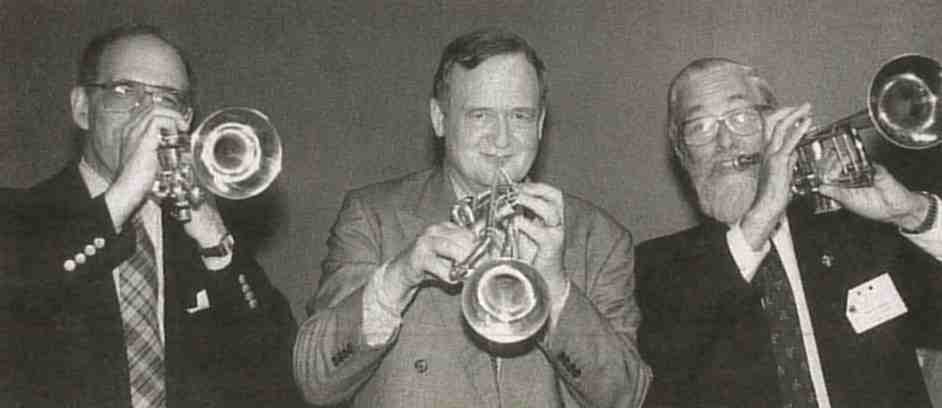 Calling the tune for Crystallography in Europe in 1996 are the officers of the European Crystallographic Committee, elected at the Lund meeting (from left) vice president, Joel Bernstein (Israel), president, Hartmut Fuess (Germany) and secretary, Arnold Smith (UK). Photo W.L.D.
Calling the tune for Crystallography in Europe in 1996 are the officers of the European Crystallographic Committee, elected at the Lund meeting (from left) vice president, Joel Bernstein (Israel), president, Hartmut Fuess (Germany) and secretary, Arnold Smith (UK). Photo W.L.D.
The structure of the first NiFe hydrogenase described by A. Volbeda provided another example of an apparent conflict between structural and spectroscopic results. In this case the crystal structure revealed a second metal (identified as an Fe) at the catalytic site, which was completely unexpected from EXAFS studies. A further surprise was the presence of three diatomic groups (probably Co or No) liganding the catalytic Fe. The presence of long hydrophobic channels leading to the deeply buried catalytic centre are suggestive of possible substrate pathways, but further predictions concerning mechanism must await the structure determination of the reduced form of the enzyme.
Finally, there was a demonstration that even a 1 Å resolution structure, with an R-factor below 10%, will not yield all its secrets. Z. Dauter described that although more than 75% of the hydrogen atoms in the structure of savinase (a subtilisin variant) are unambiguous the position of the proton associated with the catalytic triad could not be determined. It remains to be seen if further refinement or data collection at a different pH will clarify the situation. These very high resolution structures are providing invaluable information about the geometry and stereochemistry of proteins, but it is a sobering thought that even at this resolution there is no guarantee that the details of enzymatic catalysis will be apparent from the structure. (Andrew G. W. Leslie)
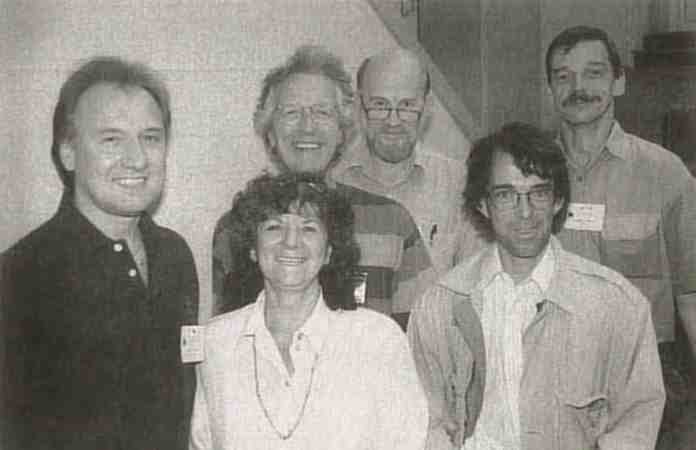 The joy of macromolecules reflected in the smiles of Ian Wilson (USA), Ada Yonath (Israel), Phil Evans (UK), Jens Nyborg (Denmark), Stanislav Nikonov (Russia), and Z. Dauter (Poland). Photo W.L.D.
The joy of macromolecules reflected in the smiles of Ian Wilson (USA), Ada Yonath (Israel), Phil Evans (UK), Jens Nyborg (Denmark), Stanislav Nikonov (Russia), and Z. Dauter (Poland). Photo W.L.D.
Proteins-Nucleic Acid Interactions: While past work on strucrures of protein-nucleic acid complexes had been primarily with DNA, advances in the synthesis and purification of RNA made it possible to devote an entire microsymposium to protein-RNA complexes. The rapid expansion of the RNA field shows no sign of abating. Crystal structures for synthetases of more than half the 20 amino acids, (several of these in complexes with the tRNA itself) have been completed. New ones announced in Lund were those for Lys, His and Gly. Despite quite a variety of overall structures, striking similarities are becoming apparent in the regions of the structures that recognize their cognate amino acids. Success in pursuit of the structure of the RNA binding domains of the Ui protein with a synthetic RNA stem loop fragment required the manufacture of large numbers of different recombinant protein mutants and different length RNA's. Rather than trying ro improve crystallization conditions that gave crystals that diffracted to 7.0 Å resolution, the investigators kept searching for variant molecules that crystallize easily eventually producing crystals that diffracted to 1.7 Å. (Simon Phillips)
Protein Synthesis: A number of new macromolecular studies are illuminating the mechanism of protein synthesis. Elongation factor-Tu (EF-Tu) is the protein factor which delivers a charged tRNA to the ribosome for each addition of an amino-acid to the growing polypeptide chain. J. Nyborg described how the molecule undergoes a major conformational change on hydrolysis of GTP to GDP. His most exciting result arose from the structure of the complex of EF-Tu and its tRNA, which has a very similar shape to EF-G, the molecule which displaces the EF-Tu/tRNA complex from the ribosome. Parts of the EF-G protein molecule seems to mimic the shape of the tRNA, a new aspect of the versatility of proteins. The structure of the complex between EF-Tu and EF-Ts, the "releasing factor" molecule which causes the release of the tightly-bound GDP from EF-Tu after hydrolysis, was reported by S. Cujsak. This complex is a dimer in the crystals, which explains the need for two molecules of GTP to be hydrolysed for each amino-acid added in protein synthesis. A. Yonath reported on the steady improvement in the maps of whole ribosomal subunits they are obtaining, using heavy atom clusters to provide phasing for these enormous molecules. In his plenary lecture on F1-ATPase, A. Leslie demonstrated with a brilliant video tape of the dancing enzyme how the three catalytic sites on the 3b subunit rotate around the g sub unit during the enzymatic reaction.
I. Wilson described how MHC class Iimolecules bind short peptides on the cell surface, and how a common site binds a variety of peptides while presenting different surfaces to receptors on other cells. (Phil Evans, Zbyszek Dauter, Maria Armenia Carrondo)
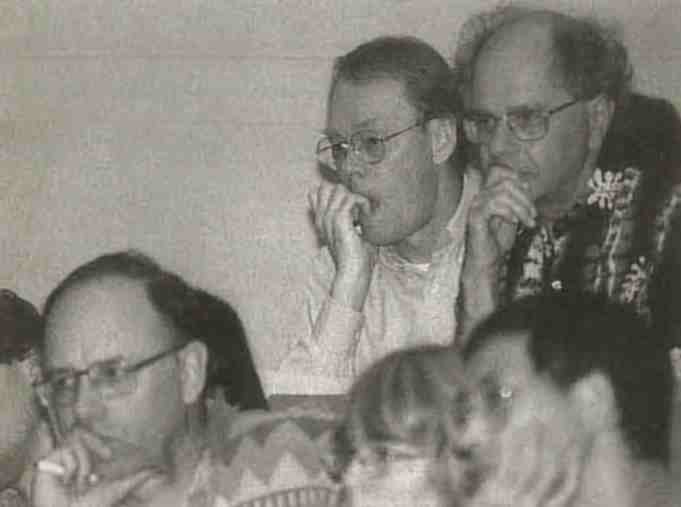 Wayne Hendrickson (USA) and Carl Brandeen (France). the coeditors of Structure (the new testament of macromolecular crystallography) gaze over the head of Anders Liljos (Sweden), to give nail biting attention to a speaker. Photo W.L.D.
Wayne Hendrickson (USA) and Carl Brandeen (France). the coeditors of Structure (the new testament of macromolecular crystallography) gaze over the head of Anders Liljos (Sweden), to give nail biting attention to a speaker. Photo W.L.D.
Virus Structures: Techniques for the determination of virus structures are now well developed. Symmetry averaging of the large number of chemically identical but crystallographically independent icosahedrally arranged subunits is a powerful tool for structure determination and phase extension. In the session on viruses and viral proteins, D. Stuart (Oxford U.) described the combined use of X-ray diffraction and electron cryo microscopy to determine the structure of a trimer from the 700A diameter core of a virus containing as many as 780 identical protein subunits. B. Berger (Purdue U.) discussed the refinement of human Rhinovirus 14 using an Intel 860 parallel computer that revealed details useful in designing drugs for the common cold. The structures of small RNA-phages differ from those of other viral coat proteins. The structure of a RNA-phage coat protein dimer complexed with RNA described by L. Liljs (Uppsala U.) revealed protein RNA interactions critical to particle assembly and regulation of expression of a viral protein. This is one of the few protein-RNA interactions studied to date. A. Wlodawer illustrated the similarity between the Integrase from Avian Sarcoma Virus and HIV. (Bror Strandberg)
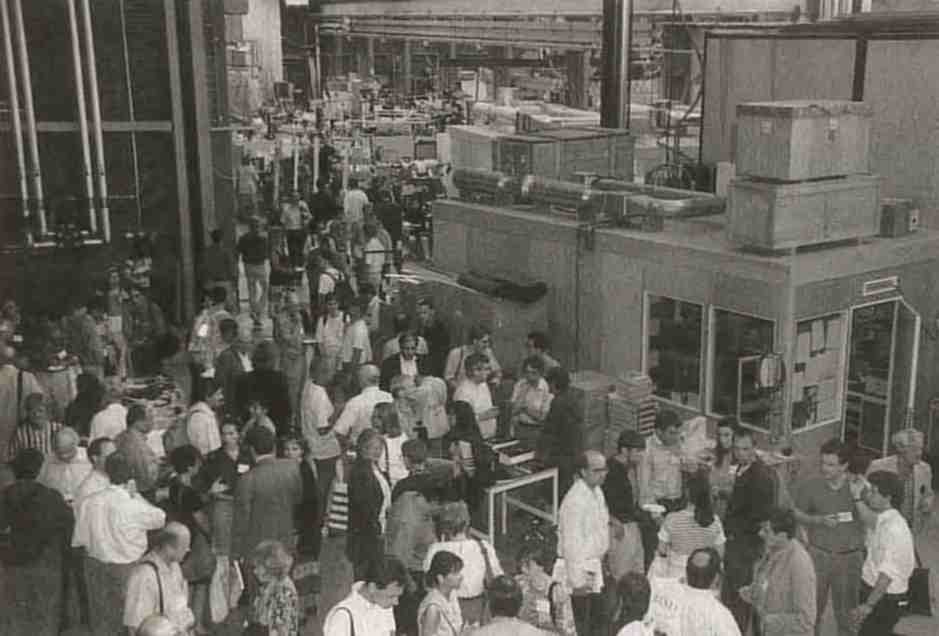 A reception at the Lund Synchrotron Facility (MAX) during ECM 16. Photo W.L.D.
A reception at the Lund Synchrotron Facility (MAX) during ECM 16. Photo W.L.D.
Materials Research
The numerous microsymposia in materials research included sessions on theory and instrumentation as well as applications and database analysis.
Aperiodic Crystals: T. Janssen gave an excellent didactical discourse on the subject of aperiodic crystals. He placed incommensurate and quasicrystalline structures in the continuum from periodic to locally ordered solids. In a systematic study of Al and Co alloys, Y. Grin identified numerous approximate structures of decagonal quasicrystals along with evidence of twinning. M. Perez-Mato presented aspects of super space symmetry and its application in the study of phase transitions and symmetry models. On the basis of recent structural studies and theoretical considerations, he questioned the validity of the Overhauser-Axe phason model used to describe incommensurate phases. W. Paciorek and G. Chapuis illustrated extreme cases of highly anharmonic incommensurate structures in organic material and the inherent difficulties associated with structural solutions and geometrical interpretations in super space. The field of composite materials was addressed by S. van Smaalen who described a mixed organic material with an interesting acoustic "sliding" mode. (Gervais Chapuis)
Take a Powder, Any Powder: Application of three different methods of ab initio structure determination of zeolites were discussed by L. B. Cusker, C. J. Gilmore and A. Clearfield in a microsymposium on the topic. The MICE computer program presented by Gilmore, which is an implementation of maximum entropy, combined with likelihood estimation proposed by Bricogne, was shown to be a valuable new tool for solving crystal structures of up to 20 atoms in the asymmetric unit from powder diffraction data. There is a growing tendency to combine different techniques such as direct methods, e1ectron microscopy and diffraction, computer modeling, searches of structural data bases, and chemical intuition in addition to X-ray and neutron diffraction, in efforts to determine powder structures. (Per-Erik Werner)
Condensed Metal Clusters: In a vivid presentation A. Simon (MPI Stuttgart, Germany) spanned an arc from the geometry of connected octahedra to compounds with spin-glass properties. The general principles derived from previously known structures are being used to tailor new compounds. Cluster condensation with ligand deficiency and inclusion of electron deficient interstitial atoms can be used to improve materials stability. These principles have been applied separately and in combination to construct finite and infinite condensed clusters of Nb, Mo, Re, and Th octahedra giving rise to interest ing physical properties. For example Mo chains in NaMo form molecular wires. Simon described the electric and magnetic properties of TbBrD (sub) y with layers of edge-sharing metal octahedra. By reversible change of the amount of interstitial D atoms the electric conductivity may be switched from insulator (y > 1) to metal (y > l). In the range of 0.7 < y < 0.9 the highest magnetic ordering is combined with the lowest ordering creating a spin glass. (Elke Koch)
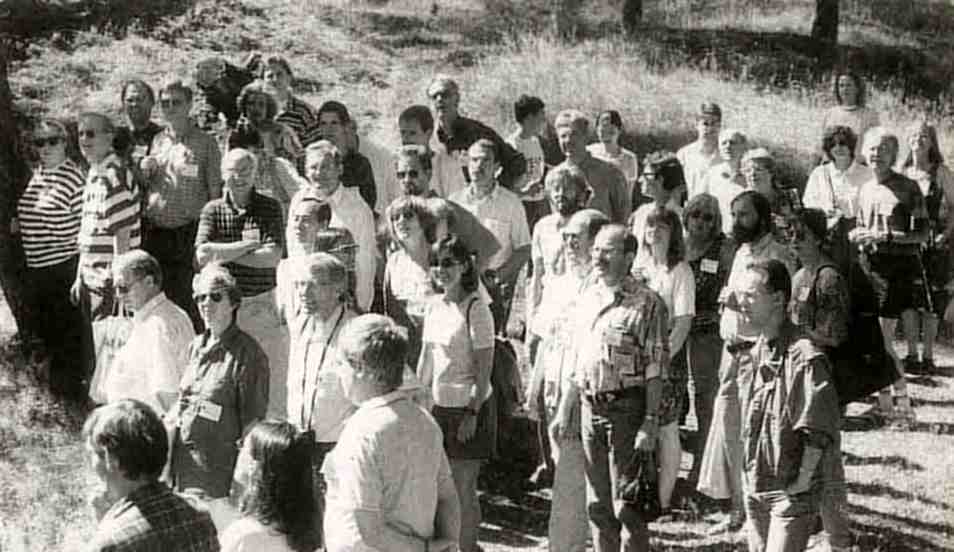 The excursion to the Alum Factory established near Lund in 1450. Photo W.L.D.
The excursion to the Alum Factory established near Lund in 1450. Photo W.L.D.
Inorganic Electron Crystallography is making significant progress in two dramatically different areas: structure determination of large biological molecules and accurate refinement of charge density distribution in small-unit cell crystals. In the former case phases extracted from high resolution images are combined with intensities from "selected area" diffraction patterns assuming kinematical scattering and linear imaging from thin objects. The charge density studies combine intensity profiles recorded in convergent beam diffraction (CBED) and accurate refinement of charge density distribution in small-unit cell crystals with extensive calculations of dynamical scattering. In the Electron Crystallography Microsymposium the determination of electron densities in semiconductors was described by R. Vincent (Bristol U.) who showed that the accuracy achieved even revealed bond distortion due to doping. Inorganic structures with moderate-sized unit cells (between the extremes of macromolecules and electron density studies) were another focus of the symposium. New schemes for intensity collection (traditional "spot patterns" for thin crystals, CBED-based schemes and a novel precession system from the Bristol group) and new strategies for analysis (Fourier methods based on kinematic scattering, refinement by Bloch-wave, and multislice calculations) were presented. The use of dynamical interactions in configurations dominated by three or four interacting beams for phase determination was the subject of a theoretical paper by A. F. Moodie and Joanne Etheridge. (Jon Gjonnes and L. Reine Wallenberg)
Structural Phase Transitions: In a Plenary lecture E. Salje (Cambridge) described the study of structural phase transitions, time dependent processes and the formation of microstructures. Focusing on local structural deformations related to atomic ordering, phonon effects and electron instabilities, he concluded that structural phase transitions follow Landau type behavior, kinetic rate laws are driven by the reduction of Gibbs free energy and kinetic microstructures are intimately twinned "tweed and stripe" materials. A microsymposium included presentations on transformations of frame work structures based upon rigid unit lattice modes including the b-incommensurate-a transition of quartz (M. Vallade, France), and strain interactions and micro twinning of ferroleastic systems (A. Bratkovsky, UK). New experimencal techniques (synchrotron radiation sources, area detectors, and time resolving detectors) permit novel approaches to the study of the thermodynamics of structural phase transitions, kinetic processes and related changes of microstructure. (U. Bismayer, Germany)
Synchrotron Radiation Crystallography: Recent results described in a session on synchrotron radiation crystallography include the structure of cellotriose from a 5 μm thick crystal and phase transitions followed at 55 intervals (Å. Kvick), structure refinement of a Co complex using data at wavelength 0.16 Å (S. O. Svensson), and stages in hydrothermal zeolite synthesis followed by high resolution powder diffraction (A. N. Christensen). (M. M. Harding)
 Crystallographers among the megaliths at "Ales stenar". Photo W.L.D.
Crystallographers among the megaliths at "Ales stenar". Photo W.L.D.
Chemical crystallography
Crystallographic Databases: In discussing resonance-assisted hydrogen bonding, G. Gilli (Ferrara) stated that crystallography was unique in having available such an extensive collection of databases, whose scientific uses were almost unlimited. F. Grepioni (Bologna) also stressed the value of completeness in database collections during an entertaining talk about the importance of both strong and weak hydrogen bonds in transition-metal complexes. J. Lommerse (CCDC) showed how database analyses and ab initio calculations were being combined to gain a deeper understanding of short interactions between halogens and electron-rich centers. The diversity of database applications was then extended by J. Loesel (Frankfurt), who has applied bond-valence methods to hydrogen bonds retrieved from inorganic crystal structures, and by P. Villars (Intermetallic Phases Databank) who described knowledge acquisition techniques applied to crystal structure data for metals and alloys. The session marked a transition in the field from studies of purely intramolecular aspects of structure to studies of the subtle interplay of forces that lead to aggregation in the solid state, and the application of this knowledge to supramolecular chemistry, rational molecular and materials design, and crystal engineering. (F. H. Allen)
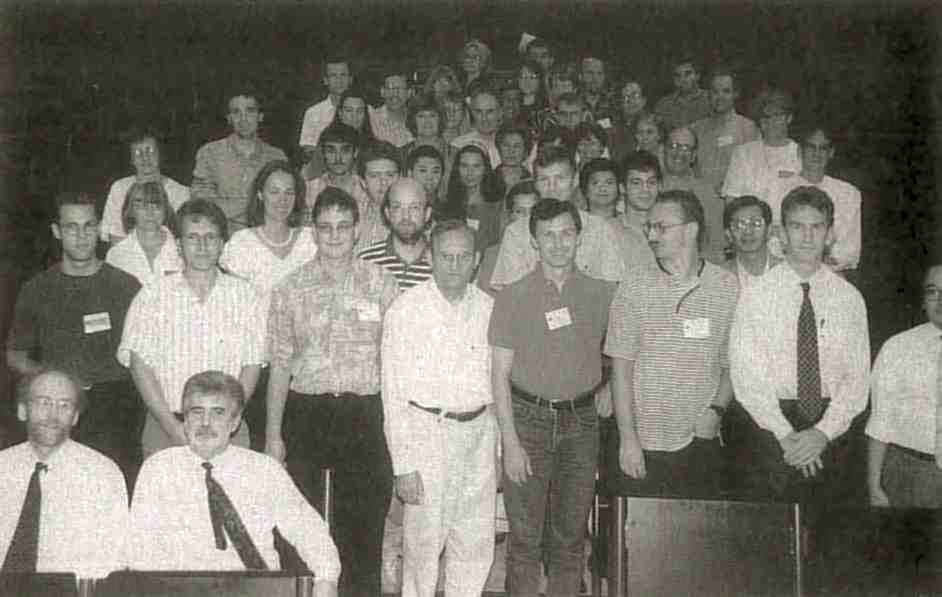 Cambridge Structural Database Workshop directors Sam Motherwell and Frank Allen (lower left) and participants. Photo W.L.D.
Cambridge Structural Database Workshop directors Sam Motherwell and Frank Allen (lower left) and participants. Photo W.L.D.
A microsymposium on Inorganic Compounds and Minerals described the systematics of polyhedra packing and demonstrated that the extensive experimental data on interatomic distances and angles can be used for prediction of polyhedra deformation due to variation of chemical composition. J. Etheridge (Cambridge, UK) noted that copper-oxygen planes of YBa2Cu3O7-8 are partitioned into cells by displacements of the apical oxygen and planar copper atoms at the boundaries of these cells, which have dimensions of the superconducting coherence length - 1 Å. These displacements are static and relax if the oxygen is reduced. (Peter Paufler)
The microsymposium Packing in Molecular Crystals addressed what has been called "one of the continuing scandals in physical sciences", the lack of "a rigorous general solution to the question of crystal-structure prediction". Gavezzotti and Gdanitz described their methods for systematically generating crystal structures by computer and the criteria for assessing their similarity of appearance. The two methods are complementary. One is based on extensive exploitation of experimental physicochemical and structural data and on energy minimization using empirical force field parameters. The other relies on a combination of molecular quantum chemical calculations with Monte-Carlo simulated annealing. In both cases the probable structures typically contain the one found experimentally. The synergies deriving from combining energy minimization, molecular dynamics simulation and X-ray crystallography were exemplified further by J. Kroon. Paterns of specific intermolecular contacts, including their noncrystallographic symmetry were presented by Zorky. This field moves slowly but steadily from the scandalous and sensational towards reason and reliability. (H. B. Bürgi)
Methods: A symposium on Methods for Structure Determination featured talks by R. Peschar (improving estimates of 2, 3 and 4-phase invariants using difference Pattersons to filter the data), J. Thomas (measurement of reflection intensities at wavelengths close to the sulfur absorption edge), and K. F. Fischer (locating the positions of anomalous scatterers from the intensities of special reflection rows measured at two or more wavelengths). Also in the session G. Ferraris showed that the structure of one mineral (nafertisite) could be deduced by combining the structures of two other (astrophyllite and bafertisite). (G. Sheldrake)


